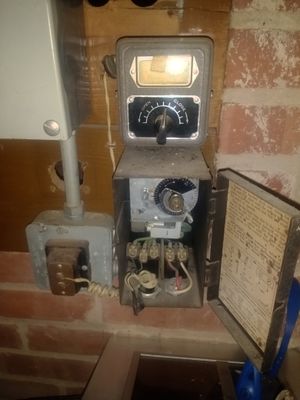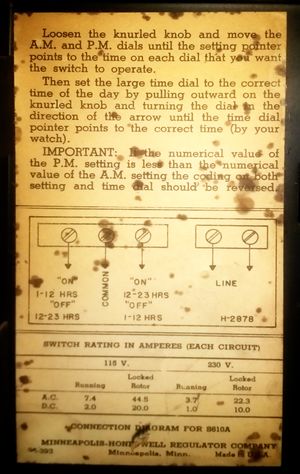Honeywell S610A
This thing has been in the basement of Hypertwin Manor apparently since it was built, but we never knew what it was until FrozenTrout started hunting around and found some information.
Apparently it is a "Honeywell Da-Nite Time Switch". A brochure[1] says:
DA-NITE TIME SWITCH
This device is an electrically operated time switch designed to automatically "break" one circuit and "make" another at a predetermined time.
The Time Switch finds many applications in the temperature control field. Warehouse systems, for example, can provide lowered night temperature or complete night shutdown.
Typical among its many other uses are control of lighting, flood lights, displays and yard lighting. Many other types of electrical equipment requiring daily S.P.S.T. or S.P.D.T. switching action can be readily operated by the S610A.
Distinctive features of the S610A include the synchronous self-starting Telechron motor, the well-known Con-Tac-Tor mercury switch, hinged cover, simplified setting, ease of mounting and two separate conduit knockouts. This latter feature permits control of either low or line voltage loads.
- TYPE
- S61A Da-Nite Time Switch. S.P.D.T. for low or line voltage loads
- VOLTAGE AND FREQUENCY — 115 volt, 60 cycle standard. Other A.C. voltages and frequencies available at extra cost.
- ELECTRICAL RATING — 8 amps. at 115 volts, 4 amps. at 230 volts; 1/2 H.P.R.I., 1/6 H.P.S.P. and D.C.
- SWITCHING INTERVAL — (Time interval between switching operations). Minimum, 1 hour; maximum, 23 hours. One complete switching cycle every 24 hours.
- FINISH — Black Kristo-Krak.
- CASE DIMENSIONS — Height, 63/4"; width, 33/4"; depth, 41/2".
- WHEN ORDERING SPECIFY
- Model number
- Voltage and frequency.
Possibly it was used for cycling power to a water heater? We're not sure; wires need to be followed to see where they go.
The timer seems to still be connected to mains power; there's a conduit running directly into the circuit-breaker box.
Footnotes
- ↑ archive.org, Control manual for heating, ventilating and air conditioning, p.30 of PDF, print page numbered 23

